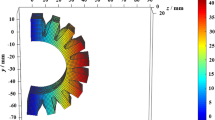Abstract
The multi-cavity soft actuator is assembled from single-cavity soft actuator through a reasonable geometric distribution. It has the characteristic that the pneumatic soft actuator is driven by its own deformation and has more degrees of freedom. Pneumatic soft actuator is widely used as an emerging discipline and its strong compliance has been greatly developed and applied. However, as the most application potential type of soft actuators, there is still a lack of simple and effective deformation prediction methods for studying the spatial deformation of multi-cavity soft actuators. To solve this problem, a vector equation method is proposed based on the analysis of the principle of the space deformation of the two-cavity, three-cavity and four-cavity soft actuators. Furthermore, a nonlinear mathematical model of the air pressure, space position and deformation trajectory of the soft actuator end is established by combining the vector equation method. Finally, the three-channel soft actuator is verified through experiments. The results show that the mathematical model can better predict the space deformation trajectory of the soft actuator, which provides a new research method for studying the space deformation of the multi-channel soft actuator.
Similar content being viewed by others
References
PAOLETTI P, JONES G W, MAHADEVAN L. Grasping with a soft glove: Intrinsic impedance control in pneumatic actuators [J]. Journal of the Royal Society Interface, 2017, 14(128): 20160867.
WEHNER M, TRUBY R L, FITZGERALD D J, et al. An integrated design and fabrication strategy for entirely soft, autonomous robots [J]. Nature, 2016, 536(7617): 451–455.
GUAN Q, SUN J, LIU Y, et al. Novel bending and helical extensile/contractile pneumatic artificial muscles inspired by elephant trunk [J]. Soft Robotics, 2020, 7(5): 597–614.
DROTLEF D M, STEPIEN L, KAPPL M, et al. Insights into the adhesive mechanisms of tree frogs using artificial mimics [J]. Advanced Functional Materials, 2013, 23(9): 1137–1146.
SEOK S, ONAL C D, CHO K J, et al. Meshworm: A peristaltic soft robot with antagonistic nickel titanium coil actuators [J]. IEEE/ASME Transactions on Mechatronics, 2013, 18(5): 1485–1497.
WANG H, KANG R, WANG X, et al. Design and modeling of a soft bending actuator [J]. Journal of Beijing University of Aeronautics and Astronautics, 2017, 43(5): 1053–1060 (in Chinese).
WEN L, WEAVER J C, LAUDER G V. Biomimetic shark skin: Design, fabrication and hydrodynamic function [J]. Journal of Experimental Biology, 2014, 217(10): 1656–1666.
RENDA F, CIANCHETTI M, GIORELLI M, et al. A 3D steady-state model of a tendon-driven continuum soft manipulator inspired by the octopus arm [J]. Bioinspiration & Biomimetics, 2012, 7(2): 025006.
MOSADEGH B, POLYGERINOS P, KEPLINGER C, et al. Pneumatic networks for soft robotics that actuate rapidly [J]. Advanced Functional Materials, 2014, 24(15): 2163–2170.
FAN X, DAI N, WANG H, et al. Bending deformation prediction method of soft actuators with pneumatic networks [J]. China Mechanical Engineering, 2020, 31(9): 1108–1114 (in Chinese).
HUANG J, XIE G, LIU Z. FEA of hyperelastic rubber material based on Mooney-Rivlin model and Yeoh model [J]. China Rubber Industry, 2008, 55(8): 467–471 (in Chinese).
FEI Y, PANG W, YU W. Movement of air-driven soft robot[J]. Journal of Mechanical Engineering, 2017, 53(13): 14–18 (in Chinese).
CHEN Y Y, LIU L, LI B, et al. Design, fabrication and performance of a flexible minimally invasive surgery manipulator integrated with soft actuation and variable stiffness [J]. Journal of Mechanical Engineering, 2018, 54(17): 53–61 (in Chinese).
XIE Z, GONG Z, WANG T, et al. Simulation and experiments of a controllable soft spatial fluidic elastomer manipulator [J]. Journal of Mechanical Engineering, 2018, 54(21): 11–18 (in Chinese).
Author information
Authors and Affiliations
Corresponding author
Additional information
Foundation item: the National Natural Science Foundation of China (No. 11604205)
Rights and permissions
About this article
Cite this article
Huo, Q., Liu, S., Xu, Q. et al. Bending Prediction Method of Multi-Cavity Soft Actuator. J. Shanghai Jiaotong Univ. (Sci.) 27, 631–637 (2022). https://doi.org/10.1007/s12204-021-2334-0
Received:
Accepted:
Published:
Issue Date:
DOI: https://doi.org/10.1007/s12204-021-2334-0




